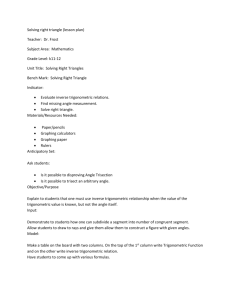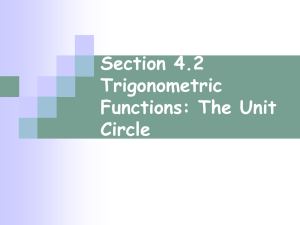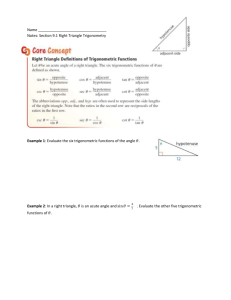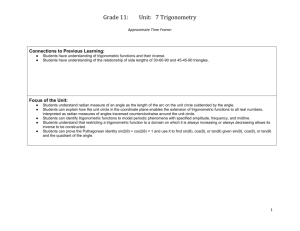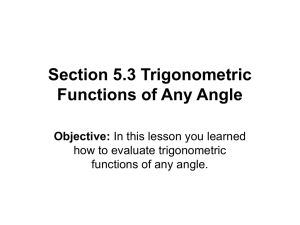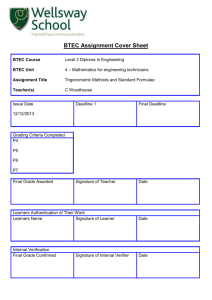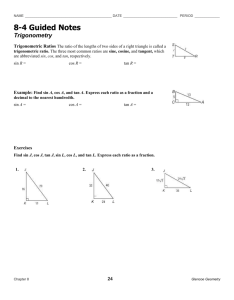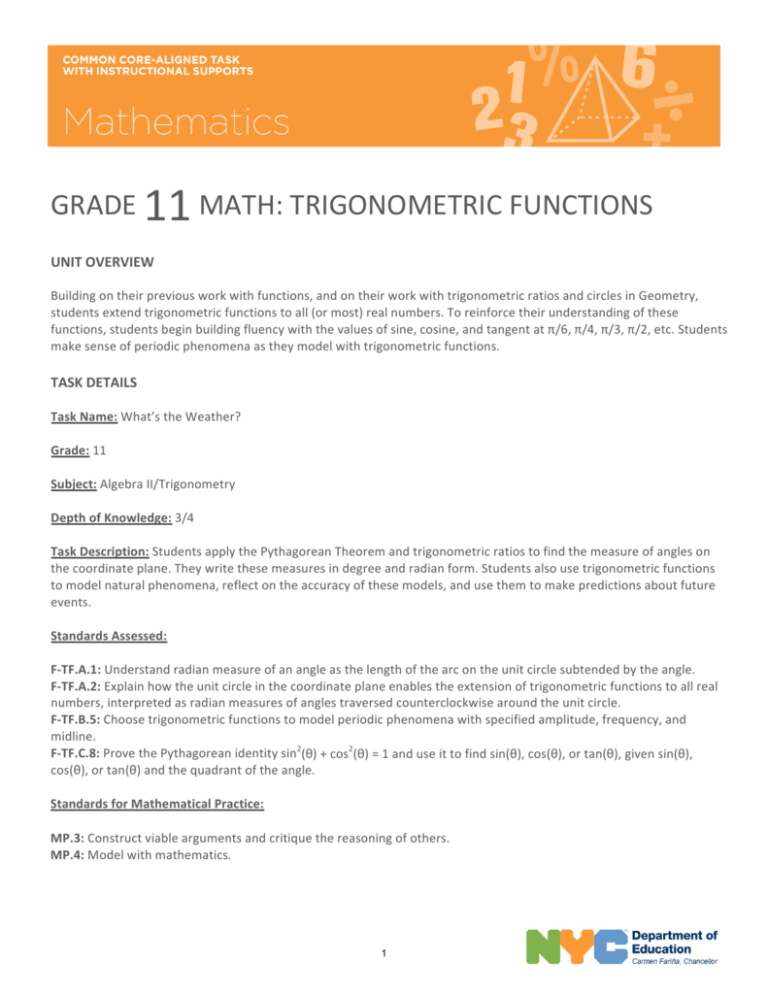
GRADE 11 MATH: TRIGONOMETRIC FUNCTIONS UNIT OVERVIEW Building on their previous work with functions, and on their work with trigonometric ratios and circles in Geometry, students extend trigonometric functions to all (or most) real numbers. To reinforce their understanding of these functions, students begin building fluency with the values of sine, cosine, and tangent at π/6, π/4, π/3, π/2, etc. Students make sense of periodic phenomena as they model with trigonometric functions.
TASK DETAILS Task Name: What’s the Weather? Grade: 11 Subject: Algebra II/Trigonometry Depth of Knowledge: 3/4 Task Description: Students apply the Pythagorean Theorem and trigonometric ratios to find the measure of angles on the coordinate plane. They write these measures in degree and radian form. Students also use trigonometric functions to model natural phenomena, reflect on the accuracy of these models, and use them to make predictions about future events. Standards Assessed: F-­‐TF.A.1: Understand radian measure of an angle as the length of the arc on the unit circle subtended by the angle. F-­‐TF.A.2: Explain how the unit circle in the coordinate plane enables the extension of trigonometric functions to all real numbers, interpreted as radian measures of angles traversed counterclockwise around the unit circle. F-­‐TF.B.5: Choose trigonometric functions to model periodic phenomena with specified amplitude, frequency, and midline. F-­‐TF.C.8: Prove the Pythagorean identity sin2(θ) + cos2(θ) = 1 and use it to find sin(θ), cos(θ), or tan(θ), given sin(θ), cos(θ), or tan(θ) and the quadrant of the angle. Standards for Mathematical Practice: MP.3: Construct viable arguments and critique the reasoning of others. MP.4: Model with mathematics. 1
TABLE OF CONTENTS The task and instructional supports in the following pages are designed to help educators understand and implement Common Core–aligned tasks that are embedded in a unit of instruction. We have learned through our pilot work that focusing instruction on units anchored in rigorous Common Core–
aligned assessments drives significant shifts in curriculum and pedagogy. PERFORMANCE TASK: TRIGOMETRIC FUNCTIONS…….……….………..…………………………………................3 RUBRIC AND SCORING GUIDE…………………………………………………………………………………………………………7 FORMATIVE ASSESSMENTS……….……………………………………………………………………………………………......13 INSTRUCTIONAL SUPPORTS……………………………………………………………………………………………………......32 UNIT OUTLINE…………………………………………………………………………………………………………………..33 EXTENSIONS……………………………………………………………………………………………………………………..57 GUIDED QUESTIONS……….………………………………….……………………………………………………………..58 VISUALS…………………….……………………………………………………………………………………………………..60 Acknowledgements: This bundle was developed by Alex Sczesnak, Cathleen Cuffie, and Carlos Bermudez from the Metropolitan High School 12X248, in collaboration with the Common Core Fellows. 2
GRADE 11 MATH: TRIGONOMETRIC FUNCTIONS PERFORMANCE TASK 3
What’s the Weather? Algebra II – Module 2: Trigonometric Functions – Performance Task 1. Use two different methods to find the measure of the angle below in standard position, showing your work for both. Express your answer in radians. 2. Given sin (θ ) = 3√5/11, find cos (θ ) and tan (θ ). Justify your answer using the Pythagorean identity. 4
3. The table below displays the average high temperature, by month, in Central Park. Average Monthly Temperature (°F) JAN FEB MAR APR MAY JUN JUL AUG SEP OCT NOV 38 42 50 61 71 79 84 83 75 64 54 DEC 43 a. Use this data to write a function representing the temperature, f(m), in month m, with January = 0. Graph this function on the axes below, labeling any critical values. 5
b. Climate scientists believe that the average high temperature in Central Park for the month of July could increase by as much as 10° by 2050. Assuming that minimum average temperature stays the same, write a second function modeling this change and use it to predict the new average high temperature for the month of October. c. Although only 12 data points are given in the table above, the function modeled above is continuous. Should average monthly temperature be expressed as a continuous function? Why or why not? d. The table below displays the average monthly rainfall, by month, in Central Park. JAN 3.65 FEB 3.21 MAR 2.36 APR 4.50 Average Monthly Rainfall (in.) MAY JUN JUL AUG 4.19 6.41 4.60 4.44 SEP 4.28 OCT 1.40 NOV 4.02 DEC 5.00 Your friend Sam wants to model this data using a function similar to the one you’ve written. Do you think this is a good idea? Why or why not? 6
GRADE 11 MATH: TRIGONOMETRIC FUNCTIONS SCORING GUIDE AND RUBRIC 7
8
9
10
What’s the Weather? Algebra II – Module 2: Trigonometric Functions – Performance Task Rubric What’s the Weather? Rubric The elements of performance required by this task are: • Uses trigonometric ratios and the Pythagorean theorem to find side lengths and angle measures on the coordinate plane • Writes angle measures in radian and degree form • Models phenomena with trigonometric functions Possible Responses Points Section Points 2 1. a) Uses arctan to find the measure of an angle θ in the fourth quadrant b) Uses the Pythagorean theorem to solve for the given side length 2 and uses this side length to find either the cosine or sine of an angle θ in the fourth quadrant 1 c) Writes this angle in radians in standard position Partial Credit 5 (1) • Draws and labels a right triangle using the given (2) • Uses only one method to find the measure of the given angle (2) Incorrectly identifies the angle θ in the fourth quadrant, leading to an incorrect final answer 2. a) Draws and labels a diagram of a right triangle b) Uses the Pythagorean theorem to find the missing side length c) Uses the missing side length to find the cosine and tangent of the given angle θ Partial Credit • Draws and labels a right triangle using the given • Incorrectly sets up the Pythagorean theorem, leading to an incorrect side length • Finds only the cosine or tangent of angle θ, but not both 3. a) Writes a function that accurately models the given data set, such as f(m) = –23cos(θπ/6) + 61 b) Draws and labels a graph corresponding to the function c) Writes a second function reflecting the altered data set, such as f(m) = –28cos(θπ/6) + 66 d) Uses the new function to find f(9) = 66 e) Gives a correct answer “yes” to part (c), using justification such as “because temperature changes gradually over time” f) Give a correct answer “no” to part (d), using justification such as “the data in the table does not change periodically and so cannot be graphed using a trigonometric function” Partial Credit • Uses trigonometry to model a function in part (a) that is incorrect • Draws a graph that does not accurately model the given data set Total Points •
11
1 2 2 (1) (1) 2 2 1 1 1 1 (1) (1) 5 18 Performance Level Descriptions and Cut Scores Performance is reported at four levels: 1 through 4, with 4 as the highest. Level 1: Demonstrates Minimal Success (0–4 points) The student’s response shows few of the elements of performance that the task demands as defined by the Common Core standards. The student’s work shows a minimal attempt and lack of coherence. The student fails to use the Pythagorean theorem or trigonometric ratios appropriately and provides little or no justification for his/her answers. The student does not accurately model the given data or demonstrate understanding in the follow-­‐up questions. Level 2: Performance Below Standard (5–10 points) The student’s response shows some of the elements of performance that the task demands as defined by the Common Core standards. The student attempts to use some tools, such as the Pythagorean theorem or trigonometric ratios, with limited success. The student might model the given data set with a trigonometric function, but ignore or fail to address some of the constraints of the problem. Level 3: Performance at Standard (11–15 points) For most of the task, the student’s response shows the main elements of performance that the task demands as defined by the Common Core standards, with few minor errors or omissions. The student explains the problem and identifies constraints. The student makes sense of quantities and their relationships in the modeling situation. The student uses appropriate tools, such as the Pythagorean theorem or trigonometric ratios. The student might discern patterns or structures and make connections between representations. The student is able to make sense of the problem and uses a trigonometric function to model the given data set, taking into consideration some or all of the constraints of the problem. Level 4: Achieves Standard at Highest Level (16–18 points) The student’s response meets the demands of nearly all of the tasks as defined by the Common Core standards and is organized in a coherent way. The communication is clear and precise. The body of work looks at the overall situation of the problem and process while attending to the details. The student routinely interprets the mathematical results, applies trigonometric concepts in the context of the situation, and reflects on whether the results make sense. The student uses a trigonometric function to model the given data set, taking into consideration all of the constraints of the problem. 12
GRADE 11 MATH: TRIGONOMETRIC FUNCTIONS FORMATIVE ASSESSMENTS 13
Algebra II – Module 2 Formative Assessment #01 [Initial Assessment] Standard G-­‐SRT.8 1. In ∆XYZ, 𝒎∡𝒀 = 90o, XY = 18 and YZ = 15. Find 𝒎∡𝒁 to the nearest degree and the length of side XZ to the nearest tenth. 2. A tree casts a shadow 20 meters from its base. The height of the tree is 30 meters. Find the angle of elevation formed by the end of the shadow and ground, rounding to the nearest degree. Then find the distance from the top of the tree to the end of the shadow, rounding to the nearest tenth. 14
Algebra II – Module 2 Formative Assessment #01 Standard G-­‐SRT.8 Formative Assessment #01 Rubric The elements of performance required by this task are: • Students use the trigonometric ratios and the Pythagorean Theorem to solve right triangles with/without context Possible Responses Points Section Points 1. Uses trigonometry and/or the Pythagorean Theorem to find 𝑚∡𝑍 2 to the nearest degree and the length of side XZ Partial Credit 2 (1) • Finds either 𝑚∡𝑍 or the length of side XZ but not both (1) • Does not round one or both answers to the correct place value 2. Uses trigonometry and/or the Pythagorean Theorem to find the 2 angle of elevation to the nearest degree and the distance from the top of the tree to the edge of the shadow. Partial Credit 2 (1) • Finds either the angle of elevation or the distance, but not both (1) • Does not round one or both answers to the correct place value Total Points 4 15
16
Algebra II – Module 2 Formative Assessment #02 Standard F-­‐TF.2 1. Find the exact value of the cosine and sine of –390o. 2. Find the measure of the given angle in standard position. 17
18
Algebra II – Module 2 Formative Assessment #02 Standard FT-­‐F.2 Formative Assessment #02 Rubric The elements of performance required by this task are: • Students find the angle measure corresponding to a coordinate on the unit circle, and use a given angle measure to find a coordinate on the unit circle Possible Responses Points Section Points 1. Uses knowledge of the unit circle and benchmark values for sine 2 and cosine to find values for the angle –390o Partial Credit 2 (1) • Uses a method other than benchmark values (for example, a calculator) to solve (1) • Finds either cosine or sine of the angle, but not both 2. Uses knowledge of reference angles and benchmark values for sine 2 and cosine to determine the angle measure Partial Credit 2 (1) • Uses the wrong reference angle but arrives at logically consistent answer Total Points 4 19
Algebra II – Module 2 Formative Assessment #03 Standard F-­‐TF.1 1. Convert 𝟏𝟏
𝟏𝟐
𝝅 to degrees. 2. Convert 480o to radians. 20
21
Algebra II – Module 2 Formative Assessment #03 Standard FT-­‐F.1 Formative Assessment #03 Rubric The elements of performance required by this task are: • Converts between angle measures in radians and degrees Possible Responses 1. Converts the angle to 165o Points Section Points 1 1 1 1 2 !!
2. Converts the angle to radians !
Total Points 22
Algebra II – Module 2 Formative Assessment #04 Standard FT-­‐F.8 1. Given 𝒔𝒊𝒏 𝜽 =
your answer. 𝟔
𝟖
find 𝒄𝒐𝒔 𝜽 and 𝒕𝒂𝒏 𝜽 in Quadrant I. Use the Pythagorean identity to justify 𝟑 𝟐
2. Given 𝒕𝒂𝒏 𝜽 =
find 𝒔𝒊𝒏 𝜽 and 𝒄𝒐𝒔(𝜽) in Quadrant III. Use the Pythagorean identity to 𝟓
justify your answer. 23
24
Algebra II – Module 2 Formative Assessment #04 Standard FT-­‐F.8 Formative Assessment #04 Rubric The elements of performance required by this task are: • Use the Pythagorean identity to find cos(Ѳ), sin(Ѳ), or tan(Ѳ) when given cos(Ѳ), sin(Ѳ), or tan(Ѳ) Possible Responses Points Section Points 1. Uses the Pythagorean identity to find cos(Ѳ) and tan(Ѳ) in 2 Quadrant I Partial Credit (1) 2 • Uses a method other than the Pythagorean identity to solve for cos(Ѳ) and tan(Ѳ) (1) • Correctly uses the Pythagorean identity to find cos(Ѳ) and tan(Ѳ), but fails to account for values in Quadrant I 2. Uses the Pythagorean identity to find cos(Ѳ) and sin(Ѳ) in 2 Quadrant III Partial Credit (1) 2 • Uses a method other than the Pythagorean identity to solve for cos(Ѳ) and sin(Ѳ) (1) • Correctly uses the Pythagorean identity to find cos(Ѳ) and sin(Ѳ), but fails to account for values in Quadrant III Total Points 4 25
Algebra II – Module 2 Formative Assessment #05 Standard FT-­‐F.5 1. Describe the difference between the graphs of the trigonometric functions 𝒇 𝜽 = 𝒄𝒐𝒔(𝜽) and 𝒈 𝜽 = 𝟑𝒄𝒐𝒔
𝜽
𝟔
− 𝟓. Make sure to use precise mathematical vocabulary. 2. Describe the difference between the graphs of the trigonometric functions 𝒇 𝜽 = 𝒔𝒊𝒏(𝜽) and 𝟏
𝒈 𝜽 = − 𝒔𝒊𝒏 𝟑𝜽 + 𝟏𝟕. Make sure to use precise mathematical vocabulary. 𝟑
26
27
Algebra II – Module 2 Formative Assessment #05 Standard FT-­‐F.5 Formative Assessment #05 Rubric The elements of performance required by this task are: • Understanding the functions f(Ѳ) = acos(b Ѳ) + k and f(Ѳ) = asin(b Ѳ) + k in terms of amplitude, frequency, and midline Possible Responses Points Section Points 1. Correctly relates coefficients a, b, and k to the modified amplitude, 2 frequency, and midline of the trigonometric function Partial Credit 2 (1) • Correctly relates two of the coefficients to the changes in the amplitude, frequency, or midline of the trig function 2. Correctly relates coefficients a, b, and k to the modified amplitude, 2 frequency, and midline of the trigonometric function Partial Credit 2 (1) • Correctly relates two of the coefficients to the changes in the amplitude, frequency, or midline of the trig function Total Points 4 28
Algebra II – Module 2 Formative Assessment #06 Standard FT-­‐F.5 Robert and his friend Hilda are riding in a Ferris wheel at the state fair. Their elevation over the first 10 minutes of their ride is recorded in the table below: Height Above the Ground TIME 0 (min) ELEVATION 0 (feet) 1 2 3 4 5 6 7 8 9 10 7 24 40 48 40 24 7 0 7 24 1. Write a periodic function, f(m), relating their elevation to the time m in minutes that they spend in the Ferris wheel. 2. Predict Robert and Hilda’s elevation at time m = 15 minutes. 3. After 15 minutes, the two friends decide they want to get off the Ferris wheel. How much longer will they have to wait before they can exit the ride? 29
30
Algebra II – Module 2 Formative Assessment #06 Standard FT-­‐F.5 Formative Assessment #06 Rubric The elements of performance required by this task are: • Model with trigonometric functions by choosing the appropriate function and adjusting the amplitude, frequency, and midline Possible Responses Points Section Points 1. Writes a correct function f(m) modeling the given data 2 Partial Credit 2 (1) • Writes a function that is partially correct but contains one conceptual error 2. Correctly predicts the Ferris wheel height at m = 15 to be approx. 2 seven feet Partial Credit 2 (1) • Substitutes m = 15 into the function, but makes one calculation error 3. Uses algebra to solve for m when f(m) = 0 and states that the 2 friends can exit at m = 16 minutes Partial Credit 2 (1) • Uses a method other than algebraic to predict when the friends can exit the Ferris wheel Total Points 6 31
GRADE 11 MATH: TRIGONOMETRIC FUNCTIONS INSTRUCTIONAL SUPPORTS 32
Unit Outline INTRODUCTION: Building on their previous work with functions, and on their work with trigonometric ratios and circles in geometry, students extend trigonometric functions to all (or most) real numbers. To reinforce their understanding of these functions, students begin building fluency with the values of sine, cosine, and tangent at π/6, π/4, π/3, π/2, etc. Students make sense of periodic phenomena as they model with trigonometric functions. Algebra II: Trigonometric Functions UNIT TOPIC AND LENGTH: Ø Module 2: Trigonometric Functions (20 days) COMMON CORE STANDARDS: Ø F-­‐TF.1: Understand radian measure of an angle as the length of the arc on the unit circle subtended by the angle* Ø F-­‐TF.2: Explain how the unit circle in the coordinate plane enables the extension of trigonometric functions to all real numbers, interpreted as radian measures of angles traversed counterclockwise around the unit circle Ø F-­‐TF.5: Choose trigonometric functions to model periodic phenomena with specified amplitude, frequency, and midline Ø F-­‐TF.8: Prove the Pythagorean identity sin2(Ѳ) + cos2(Ѳ) = 1 and use it to find sin(Ѳ), cos(Ѳ), or tan(Ѳ), given sin(Ѳ), cos(Ѳ), or tan(Ѳ) and the quadrant of the angle* *TF.1 and TF.8 are partially assessed in the formative and performance tasks but are covered completely in the learning activities. BIG IDEAS/ENDURING UNDERSTANDINGS: ESSENTIAL QUESTIONS: Ø Converting radians to degrees and degrees Ø How is radian angle measure defined? to radians Ø What is the unit circle and how does it Ø Valuing trigonometric functions for any define the value of any trigonometric degree measure, even those greater than function at a given angle? °
2π or 360 Ø How can we manipulate the amplitude, Ø Modeling periodic phenomena with trigonometric functions by manipulating amplitude, frequency, and midline frequency, and midline of a trigonometric function? Ø How can we use trigonometric functions to model periodic data? Ø Using the Pythagorean identity to rewrite expressions and equations involving trigonometry Ø What is the Pythagorean identity and how can we use it to rewrite expressions and equations? 33
VOCABULARY/KEY TERMS: Ø TOPIC 1: REVIEW o
TRIGONOMETRY, FUNCTION, SINE, COSINE, TANGENT, RIGHT TRIANGLE, OPPPOSITE/ADJACENT SIDES, HYPOTENUSE, SUPPLEMENTARY, COMPLEMENTARY, INVERSE (OR ARC) Ø TOPIC 2: UNIT CIRCLE o
UNIT CIRCLE, DEGREES, STANDARD POSITION, REFERENCE ANGLE, INITIAL SIDE, TERMINAL SIDE, QUADRANT Ø TOPIC 3: RADIANS AND DEGREES o
RADIANS, PI, ARC, ARC LENGTH Ø TOPIC 4: PYTHAGOREAN IDENTITY o NO NEW VOCABULARY INTRODUCED Ø TOPICS 5 AND 6: MANIPULATING/MODELING WITH TRIG FUNCTIONS o
AMPLITUDE, FREQUENCY, MIDLINE, PERIOD/CYCLE ASSESSMENT EVIDENCE AND ACTIVITIES: INITIAL ASSESSMENT: SEE FORMATIVE ASSESSMENT #01 FOR INITIAL ASSESSMENT FORMATIVE ASSESSMENT: SEE FORMATIVE ASSESSMENTS #02-­‐06 FINAL PERFORMANCE TASK: SEE “WHAT’S THE WEATHER?” PERFORMANCE TASK LEARNING PLAN AND ACTIVITIES: ØØ Day 1–3: Diagnostic/Review Objectives: • Students complete the formative assessment #01 [initial assessment]. • Students use trigonometric ratios and the Pythagorean theorem to solve right triangles in applied problems. UDL Supports/Suggestions: • Teacher can scan over students’ initial assessments to come up with small learning groups for students with incorrect responses. • Students that got both assessment items correct can be paired with students who got only one question correct. ØØ Day 4: Radians Objectives: • Students understand radian measure of an angle as the length of the arc on the unit circle subtended by the angle. 34
Students complete radian activity 1 from Project Maths. (http://www.projectmaths.ie/documents/radian_activity_1.pdf) UDL Supports/Suggestions: • Provide students with worked examples for guidance. ØØ Day 5: Radians Objectives: • Students understand radian measure of an angle as the length of the arc on the unit circle subtended by the angle. • Students complete formative assessment #03. UDL Supports/Suggestions: • Teacher can scan over students’ formative assessments to come up with small learning groups for students with incorrect responses. •
ØØ Day 6: Unit Circle Objectives: • Students understand radian measure of an angle as the length of the arc on the unit circle subtended by the angle. • Students complete NCTM “paper plate” activity. (http://www.loganschools.org/curriculum/mathematics/Paper_plate_unit_circle.pdf) UDL Supports/Suggestions: • Pair students with strong literacy skills with students with weak literacy skills. ØØ Day 7: Unit Circle Extensions Objectives: • Students are able to explain how the unit circle in the coordinate plane enables the extension of trigonometric functions to all real numbers, interpreted as radian measure of angles traversed counterclockwise around the unit circle. • Students complete Shmoop trigonometric functions worksheet. (http://www.shmoop.com/common-­‐core-­‐standards/handouts/f-­‐tf-­‐worksheet_2.pdf) UDL Supports/Suggestions: • Provide worked examples for students. ØØ Day 8: Unit Circle Extensions Objectives: • Students are able to explain how the unit circle in the coordinate plane enables the extension of trigonometric functions to all real numbers, interpreted as radian measure of angles traversed counterclockwise around the unit circle. • Students complete the illustrative mathematics activity “Trigonometric functions for arbitrary angles.” (http://www.illustrativemathematics.org/illustrations/1692) UDL Supports/Suggestions: • Provide a worked example for a similar problem. ØØ Day 9: Pythagorean Identity 35
Objectives: • Students prove the Pythagorean identity. • Students complete the Illustrative Mathematics activity. (http://www.illustrativemathematics.org/illustrations/1693) ØØ Day 10–11: Pythagorean Identity Objectives: • Students use the Pythagorean identity to find sin(Θ), cos(Θ), and tan(Θ), given either sin(Θ), cos(Θ), or tan(Θ) and the quadrant. • Students complete Shmoop worksheet. (http://www.shmoop.com/common-­‐core-­‐
standards/handouts/f-­‐tf-­‐worksheet_8.pdf) UDL Supports/Suggestions: • Provide worked examples for students. ØØ Day 12: Pythagorean Identity Objectives: • Students use the Pythagorean identity to find sin(Θ), cos(Θ), and tan(Θ), given either sin(Θ), cos(Θ), or tan(Θ) and the quadrant. • Students complete formative assessment #04 UDL Supports/Suggestions: • Use the formative assessment to group students and make small learning groups. ØØ Day 13: Modeling Trigonometry Objectives: • Students can graph trigonometric functions, showing period, midline, and amplitude. • Students complete Jones College Prep worksheet. (http://www.jonescollegeprep.org/ourpages/auto/2012/5/17/67104659/graphing%20t
rig.pdf) UDL Supports/Suggestions: • Provide worked examples for students. ØØ Day 14: Modeling Trigonometry Objectives: • Students can graph trigonometric functions, showing period, midline, and amplitude. • Students complete Kuta worksheet. (http://www.kutasoftware.com/FreeWorksheets/Alg2Worksheets/Translating%20Trig
%20Graphs.pdf) UDL Supports/Suggestions: • Provide visual examples of the different graphs and their transformations. ØØ Day 15: Modeling Trigonometry Objectives: • Students choose trigonometric functions to model periodic phenomena with specified amplitude, frequency, and midline. 36
Students complete Illustrative Mathematics task “As the Wheel Turns.” (http://www.illustrativemathematics.org/illustrations/595) ØØ Day 16: Modeling Trigonometry Objectives: • Students choose trigonometric functions to model periodic phenomena with specified amplitude, frequency, and midline. • Students complete Illustrative Mathematics task “Foxes and Rabbits 2.” (http://www.illustrativemathematics.org/illustrations/816) •
ØØ Day 17: Modeling Trigonometry Objectives: • Students choose trigonometric functions to model periodic phenomena with specified amplitude, frequency, and midline. • Students complete Illustrative Mathematics task “Foxes and Rabbits 3.” (http://www.illustrativemathematics.org/illustrations/817) ØØ Day 18: Modeling Trigonometry Objectives: • Students choose trigonometric functions to model periodic phenomena with specified amplitude, frequency, and midline. • Students complete formative assessment #05. UDL Supports/Suggestions: • Use the formative assessment to group students and make small learning groups. ØØ Day 19: Review Objectives: • Students choose trigonometric functions to model periodic phenomena with specified amplitude, frequency, and midline. ØØ Day 20 : Cumulating Task RESOURCES: Ø Geometer’s Sketchpad or related software is excellent for demonstrating properties of the unit circle Ø Wikipedia.org has useful articles on trigonometric functions and their properties Ø A collection of visuals related to this unit is included in the bundle 37
Serving Unit-Circle Trigonometry on a Paper Plate
Vicki Lyons & Todd Vawdrey
Lone Peak High School, Highland, UT
Presented at the 2008 NCTM National Conference, SLC, UT
Time needed: Most of 1 class period to create triangles and find degree measures. A part of another
day to find and label the radian measurements.
Materials needed for each student: cheap paper plate, 3 sheets of colored paper with a circle of 14.5
cm diameter copied on each paper (the size of the center circle on the paper plate), ruler, glue stick,
scissors, and either 4 colors of markers OR stickers (if using stickers you’ll need 4 different colors, 4
of each color + 1 extra of one of the colors = 17). It works really well 3 colors of the stickers/markers
match the colored paper.
1) Create 45 degree piece:
a) Cut out a circle of the first color. Fold in half, in half again, and in half again. Unfold. Ask:
What is the measure of the central angles created? (45 degrees) Why do we know it is 45
degrees?
b) Place the circle on the center of the paper plate, and use the folds as a guide to make the x & y
axis through the center of the paper plate, set the plate aside.
c) Refold so you have a quarter circle. You will see one bisecting fold. Hold so that the solid
folded edge is up and the open flaps down, cut along the fold almost to the
point, then angle your scissors upwards and cut off the upper half. This will
leave a little connecting piece. (When you unfold, and it will look like a bow
tie with a tiny center.) Use a ruler to drop a perpendicular from one outside
corner down to the radius, and cut off the curved part of the circle, so it
looks like a true triangle.
Ask: What kind of triangle is this? (isosceles right triangle) Why do we
know it is isosceles? Why do we know it is a right triangle? Which sides are equal?
Ask: If we call the hypotenuse length = 1, what is the length of the legs of the triangle?
Rationalize the denominator.
d) Glue the “bow tie” onto the center of the paper plate, so the x axis is going through the length of
the bowtie. Redraw the x-axis so you can see it. On the paper plate, label the (x,y) points in
each quadrant at the edges of the bow tie, using the distances found. (NOTE: Write close to the
bow tie, later you will be writing (or using stickers) to label the radian measurements, so need
space on rippling edges of the paper plate.)
2) Create 60 degree piece:
a) Cut out a circle of the second color. Fold in half. CAREFULLY make two more folds, dividing
the half circle into 1/3 sections (ice cream cone). It works best if you fold one section forward and
38
one section back. Fold the ice cream cone in half. Unfold. Ask: What is the measure of the
central angles created? (60 degrees) Why do we know they are 60 degrees?
b) Refold into a quarter circle. You will see two trisecting folds. Hold the quarter circle so the
solid fold is up and the flaps are down. Cut along the upper fold almost to the center, then angle
the scissors up and cut off the upper 1/3 of the paper, leaving a little connecting piece. (If you
unfolded it, it would be a bowtie.)
Using a ruler, drop a perpendicular from perimeter of the upper cut-off fold, down to the radius.
Cut off the perpendicular, removing curved part of the circle.
c) Ask: What type of triangle is this? (30-60-90) How do we know? Which edge is the radius of
the original circle? (Hypotenuse) If the length of the hypotenuse is 1, what are the lengths of
each of the legs?
d) Unfold, and glue the bow tie on to the paper plate. Label the (x, y) points on the bow tie, using
the lengths of the legs of the triangle. Redraw the x-axis.
3) Create the 30 degree angle piece: Follow directions as above. Instead of cutting on the top
fold, cut on the lower fold. Be sure to leave a small connecting piece for the bow tie. Glue to
paper plate and label the (x, y) points of the bow tie.
Finish by adding degree markings at each axis and in each quadrant, on the very outer edges of
the plate. Leave room to add radians on the ribbed part of the plate.
Radians
When ready to discuss radian measurements, use stickers or colored markers to label the radian
measurements on the outer edge of the paper plate. Use two stickers at the 0, 360 position.
39
Trigonometry Worksheet 2
1. If θ is angle between the line joining
the origin and the point P (4, 3) and xaxis, find csc θ.
6. Give the signs of the six trigonometric
.
functions for each angle 5π
4
2. If θ is angle between the line joining
the origin and the point P (−5, 5) and
x- axis, find tan θ.
7. Give the signs of the six trigonometric
functions for each angle 11π
.
6
8. Given cos(θ) = − 35 with θ in quadrant
III, find tan θ.
3. If θ is angle between the line joining the
origin and the point P (−9, −40) and xaxis, find cos θ.
4. Give the signs of the six trigonometric
functions for each angle π6 .
5. Give the signs of the six trigonometric
functions for each angle 2π
.
3
9. Given sin(θ) =
III, find cos θ.
45
53
with θ in quadrant
10. Given tan(θ) =
III, find sin θ.
3
4
with θ in quadrant
c
2012
Shmoop University, Inc. All rights reserved. For classroom use only. Want to print this out for your
classroom? Go for it. All other reproduction and distribution is prohibited.
http://www.shmoop.com/calculus/
Shmoop will make you a better lover (of literature, math, life...)
40
Illustrative Mathematics
F-TF Trigonometric functions for arbitrary angles
Alignments to Content Standards
Alignment: F-TF.A.2
Tags
• This task is not yet tagged.
Below is a picture of a right triangle with a the measure of angle A:
Joyce knows that the sine of a is the length of the side opposite A divided by length of the
hypotenuse :
sin a =
|BC|
.
|AC|
Joyce says, ``the sine of an obtuse angle does not make any sense because I can't make a right
triangle with an obtuse angle.''
a. Draw a picture and explain how Joyce might define the sine of an obtuse angle.
b. What are sin
3π
4
and sin π? Why?
41
Commentary
The purpose of this task is to examine trigonometric functions for obtuse angles. The values sin x
and cos x are defined for acute angles by referring to a right triangle one of whose acute angles
measures x. For an obtuse angle, no such triangle exists and so an alternate definition is
required.
Prior to working on this task, students should have experience working with trigonometric
functions and how they relate to the unit circle. The task provides a means to assess student
learning of these definitions. One advantage to working with points on the unit circle is that sine
and cosine of angles like 0 and π still make sense even though they do not belong to any
triangle.
Solutions
Solution: 1
a. Joyce is right that there is no right triangle with an angle of measure a if a > 90 . She is
also right that that the definition of sin a in terms of right triangles does not make
sense. Instead, we can begin by drawing an angle of measure a, inscribed in a circle of
−→
radius 1, with ray AB along the positive x-axis:
Consider an acute angle BAD of measure θ, inscribed in a circle,
The coordinates of D are (cos θ, sin θ). We can use this fact to make sense of sin a and
cos a for the obtuse angle a. In other words, for the obtuse angle a we define sin a and
cos a so that
C = (cos a, sin a).
42
Looking at the picture, we can see that for angles with measure 90 < a < 180 , we will
have sin a > 0 and cos a < 0.
b. The circumference of the unit circle is 2π so an angle of π/2 is a right angle and π/4 is
half of a right angle or 45 degrees. Below is a picture of an angle of measure 3π/4 :
If the purple circle is a unit circle, then from part (a) we have sin 3π/4 = |CD| and
cos 3π/4 = −|AD| . We have that △ADC is a 45-45-90 triangle and so C = (−√2‾ /2, √2‾ /2).
‾ /2 and cos 3π/4 = −√2‾ /2.
So we have sin 3π/4 = √2
The circumference of the unit circle is 2π so an angle of π is half of the circle or 180
degrees. An angle of measure π is picured below and it is a line:
The coordinates of C are (-1,0) so sin π = 0 and cos π = −1.
F-TF Trigonometric functions for arbitrary angles is licensed by Illustrative
Mathematics under a Creative Commons Attribution-NonCommercial-ShareAlike 4.0
International License
43
Illustrative Mathematics
F-TF Trigonometric Ratios and the Pythagorean Theorem
Alignments to Content Standards
Alignment: F-TF.C.8
Tags
• This task is not yet tagged.
a. In the triangle pictured above show that
|AB| 2
|BC| 2
+
=1
( |AC| )
( |AC| )
b. Deduce that sin2 θ + cos2 θ = 1 for any acute angle θ.
c. If θ is in the second quadrant and sin θ =
explain.
8
17
what can you say about cos θ? Draw a picture and
44
Commentary
The purpose of this task is to use the Pythagorean Theorem to establish the fundamental
trigonometric identity sin2 θ + cos2 θ = 1 for an acute angle θ. The reasoning behind this identity
is then applied to calculate cos θ for a given obtuse angle. In order to successfully complete part
(c) students must be familiar with the definitions of trigonometric functions for arbitrary angles
using the unit circle (F-TF.2).
The Pythagorean Theorem requires △ABC to be a right triangle and so ∠A must be acute. So
the reasoning in parts a and b of this task establish the identity
sin2 θ + cos2 θ = 1
for acute angles only. Using the unit circle as in part c, however, shows that this identity is true
for all angles. More about this can be found in
http://www.illustrativemathematics.org/tasks/1692
.
Solutions
Solution: 1
a. The Pythagorean Theorem says that if △ABC is a right triangle with right angle B then
|AB|2 + |BC|2 = |AC|2 . Dividing both sides by |AC|2 gives
|AB| 2
|BC| 2
+
= 1.
( |AC| )
( |AC| )
b. If 0 < m(θ) < 90, then we can make a right triangle ABC, as pictured in the problem
statement, so that m(∠BAC) = θ:
Then from part (a) we have
|AB| 2
|BC| 2
+
= 1.
( |AC| )
( |AC| )
We also know that
|AB|
|AC|
= cos θ and
|BC|
|AC|
= sin θ so we have sin2 θ + cos2 θ = 1.
c. Below is a picture of an angle θ in the second quadrant with sin θ =
45
8
:
17
In the picture, the purple circle is the unit circle. The coordinates of C are (cos θ, sin θ)
and since C lies on the unit circle we have
sin2 θ + cos2 θ = 1.
Since sin θ =
8
17
we can solve for cos θ and we find cos θ = ±
second quadrant cos θ = −
15
.
17
15
.
17
Since we are in the
F-TF Trigonometric Ratios and the Pythagorean Theorem is licensed by Illustrative
Mathematics under a Creative Commons Attribution-NonCommercial-ShareAlike 4.0
International License
46
Trigonometry Worksheet 8
1. Given sin θ =
cos θ.
3
5
in quadrant II, find
6. Given tan θ =
cos θ.
2. Given cos θ = − 23 in quadrant III, find
sin θ.
3. Given cos θ =
tan θ.
3
5
1
4
3 in quadrant III, find
7. Given tan θ = −1 in quadrant II, find
sin θ.
1
in quadrant IV, find
8. Given sin θ = − 10
cos θ.
in quadrant IV, find
4. Given sin θ = − 76 in quadrant III, find
tan θ.
5. Given cos θ =
sin θ.
√
9. Given cos θ =
tan θ.
1
2
in quadrant I, find
10. Given cos θ = − 25 in quadrant II, find
sin θ.
in quadrant IV, find
c
2012
Shmoop University, Inc. All rights reserved. For classroom use only. Want to print this out for your
classroom? Go for it. All other reproduction and distribution is prohibited.
http://www.shmoop.com/calculus/
Shmoop will make you a better lover (of literature, math, life...)
47
48
49
50
51
Illustrative Mathematics
F-TF Foxes and Rabbits 3
Alignments to Content Standards
Alignment: F-TF.B.5
Tags
• This task is not yet tagged.
Given below are two graphs that show the populations of foxes and rabbits in a national park
over a 24 month period.
52
a. Explain why it is appropriate to model the number of rabbits and foxes as trigonometric functions of
time.
b. Find an appropriate trigonometric function that models the number of rabbits, r(t), as a function of
time, with t in months.
c. Find an appropriate trigonometric function that models the number of foxes, f (t), as a function of time,
with t in months.
53
Commentary
The example of rabbits and foxes was introduced in 8-F Foxes and Rabbits to illustrate two
functions of time given in a table. The same situation was used in F-TF Foxes and Rabbits 2 to
find trigonometric functions modeling the data in the table. The previous situation was
somewhat unrealistic since we were able to find functions that fit the data perfectly. In this task,
on the other hand, we do some legitimate modelling, in that we come up with functions that
approximate the data well, but do not perfectly match, the given data.
This task is best used for instruction. It lends itself well to students working together in groups
and comparing their modeling functions. Different groups might come up with different function
formulas. Students have to make several choices. They have to decide which values to use for
maximum and minimum values. They also have to choose which trigonometric function to use
for their model since it is possible to use positive or negative sine or cosine functions with
different horizontal shifts for both populations.
Solutions
Solution: Solution
a. Looking at the graphs, we notice that both populations have the basic shape of cosine
and sine functions, even though there is some irregularity in the data. We can only
see the data for two years, but it is reasonable to assume that the pattern will repeat
itself in future years, and we are looking at periodic functions
b. To model the data with a cosine or sine function, we are looking for a function of the
form A sin(B(t − D)) + C or A cos(B(t − D)) + C, where |A| is the amplitude, C is the
2π
midline, B = period , and D is the horizontal shift. Looking at the graph, we observe that
the rabbit population has a vertical intercept more or less at its midline and then
decreases. This suggests the use of a negative sine function, r(t) = −|A| sin(Bt) + C,
since it does not require a horizontal shift.
Now, we just have to find the amplitude and the midline, and to do this we only need
to estimate the maximum value and minimum value of the function. The context and
2π
2π
the data suggest that the period is 12 months, so B = period = 12. From the plot, we
can estimate the minimum rabbit period population to be 600 and the maximum
rabbit population to be 1500. That gives us an amplitude of (1500 − 600)/2 = 450
rabbits and a midline of (1500 + 600)/2 = 1050 rabbits. Therefore, we have
r(t) = −450 sin( π6 t) + 1050.
Graphing r(t) together with our data points confirms that our function is a good model
for the given data, even though it does not match the data perfectly.
54
c. Again, we have to decide if we want to use sine or cosine to model this function.
Looking at the graph, we observe that the fox population has a vertical intercept at its
maximum and then decreases. This suggests the use of the cosine function
r(t) = A cos(B(t − D)) + C, where A is the amplitude, B =
2π
,
period
C is the midline, and the
horizontal shift D = 0. From the graph, we estimate the minimum value to be 50 foxes
and the maximum value to be 170 foxes. This gives us A = (170 − 50)/2 = 60 ,
2π
π
C = (170 + 50)/2 = 110 and B = period
= 2π
, and we have f (t) = 60 cos( 6 t) + 110.
12
Graphing f (t) together with our data points confirms that our function is a good model
for the given data, if not perfect.
55
F-TF Foxes and Rabbits 3 is licensed by Illustrative Mathematics under a Creative
Commons Attribution-NonCommercial-ShareAlike 4.0 International License
56
Algebra II – Module 2 Extensions F-­‐TF.3 Use special triangles to determine geometrically the values of sine, cosine, and tangent for π/3, π/4, and π/6, and use the unit circle to express the values of sine, cosine, and tangent for π – x, π + x, and 2π – x in terms of their values for x, where x is any real number. F-­‐TF.9 Prove the addition and subtraction formulas for sine, cosine, and tangent, and use them to solve problems. 57
Algebra II – Module 2 Guiding Questions Task 1 Question 1 • What is the value of the side opposite to angle Z? • What is the value of the side adjacent to angle Z? • Which trigonometric ratio would you use to find angle Z? • How could you find the length of XZ using Pythagorean theorem? Task 1 Question 2 • How would you describe the angle of elevation? • What is the relationship between the height of the tree and the angle of elevation? • What is the relationship between the height of the tree and the angle of elevation? • Which trigonometric ratio can you use to find the value of angle? • How do you find the inverse of a trigonometric function? Task 2 Question 1 • What trigonometric function is positive in quadrant IV? • 390 degrees is 1 complete turn plus what angle? Task 2 Question 2 • What are the characteristics of an angle in standard position? • What does (cos θ, sin θ) mean for an angle in standard position? • What trigonometric function is positive in quadrant II? Task 3 Question 1 • What is the relationship between radian measure and degrees? Task 3 Question 2 • 180 degrees is equivalent to how many radians? • How would you check your answer? Task 4 Question 1 • Which trigonometric function is positive in each quadrant? • How would you describe the sine, cosine, and tangent functions in terms of opposite, adjacent, and hypotenuse? 58
Algebra II – Module 2 Guiding Questions Task 4 Question 2 • Which trigonometric function is positive in each quadrant? • How would you describe the sine, cosine, and tangent functions in terms of opposite, adjacent, and hypotenuse? Task 5 Question 1 • What are the period, amplitude, and value of b in each graph? • Which value causes a shift in the second graph? • What is the pattern for graphing the cosine function? Task 5 Question 2 • What are the period, amplitude, and value of b in each graph? • Which value causes a shift in the second graph? • What is the pattern for graph sine function? Task 6 • What are the characteristics of a periodic function? 59
Degrees to Radians 60
Reference Angles 61
Right Angles + SOH CAH TOA 62
Sin + Cosine Curves 63
Unit Circle 64


